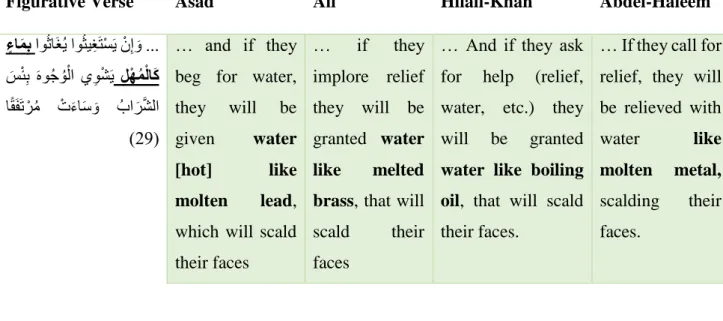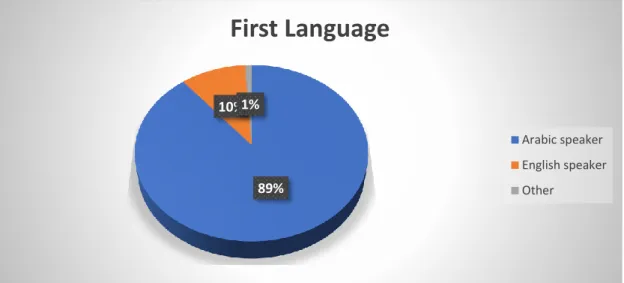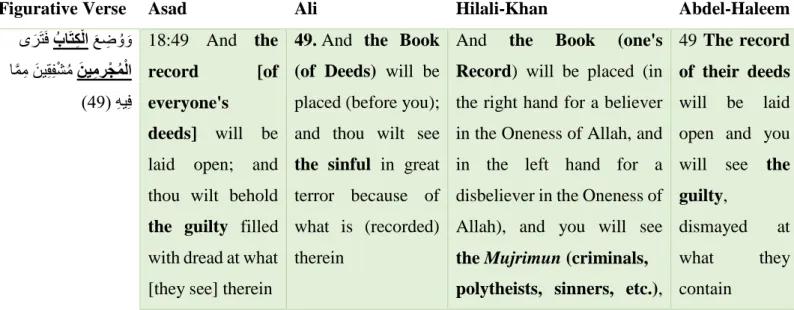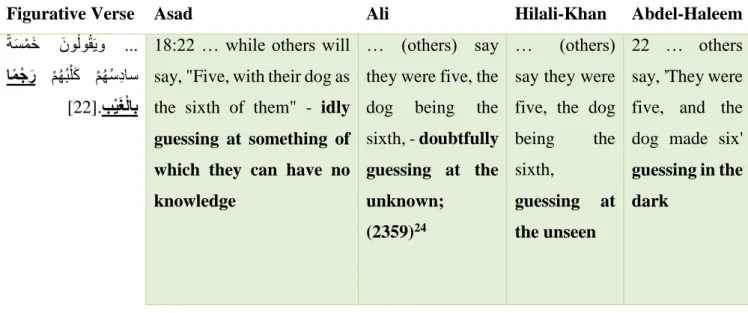Translation of Qur'anic Parables in Surat al-Kahf: Contrastive Cultural Analysis of Figurative Language in the Noble Qur'an. The following transliterations are taken from the Library of Congress Arabic Romanization System, to facilitate the reading of the Arabic script for non-Arabic speakers. Given the sacred and sensitive nature of the Qur'an, this study is designed to provide a thorough contrastive cultural analysis of the figurative language used in four reliable Qur'anic translations (Asad's, Ali's, Hilali-Khan's and Abdel-Haleem's translations) of the four parables mentioned in Surat al-Kahf.
The study highlights the challenges and the strategies employed to overcome Quran-specific and culture-specific figurative language. Moreover, the study proposes to use communicative exegetical translation (or facilitative interpretive approach) through lexical expansion procedures as the ideal strategy to be applied especially when translating Quranic parables. The eclectic methodology used for data collection is conducted quantitatively to examine the reader's understanding of the translated figurative language of the Qur'an, and conducted qualitatively to contrast the cultural strategies used in the selected translations of the aforementioned surah. analysis, thereby improving the findings and results of the study. .
صخلم طلل ًارظن
عبالل ساسحلاو سدقملا
دقف ، تممص
ءارج يفاقث ليلحت
ا ةغلل لماشيزاجمل
ةينآرق تامجرت عبرأ يف ةدوجوملا ة ةفورعم
يهو
يلع
ويللاه
عبرةيزمر صصق
تايدحتلا ىلعاهفداص يتلا
تايجيتارتسلااوعبرلأا نومجرتملا ءلاؤه اهدمتعا يتلا
ةىلع بلغتلل
ةمجرت ةبوعصو نآرقلاب ةصاخلا ةيزاجملا ةغللا
ب ةصاخلا ةفاقثلا
ةيبرعلاو ةيملاسلإا ظافحلا عم ،
ىلعىنعملا
قلا ىلع دامتعا ةساردلا حرتقت ،كلذ ىلإ ةفاضلإاب .نيفدهتسملا ءار
تلا ةيريسفتلا ةمجرتلايلصاو
لا يريسفتلا جهنلا وأ(
م للاخ نم )رسي
يمجعملا عسوتلا
لا ةيلاثم ةيجيتارتسإكدامتع
صاخ اهة
يف ةمجرت
ةينآرقلا تعبتا
ةطلتخملا ةيجهنملا
ك لكشب تانايبلا عمجل ةمدختسملال يم
ةساردلا ةغلل ئراقلا مهف
ةمجرتملا ةينآرقلا ة امك
تعبتانيابتلا ليلحتلل يعون لكشب
ةراتخملا تامجرتلا يف ةمدختسملا ةيفاقثلا تايجيتارتسلال
جئاتن زيزعت يلاتلابو ،ةروكذملا ةروسللثحبلا
ةيحاتفملا تاملكلالا ةغللا ،نآرقلا ةمجرت ،نآرقلا
زاجمةي
Literature Review
Rendering the magnificent literary effect of the Qur'an is by far the most difficult task to achieve during the translation process. The Qur'an (sometimes spelled Qur'an), the Holy Book of the Islamic faith, was revealed by God (Allah) over 1400 years ago to His Messenger, the Prophet Mohammad (SAAW), in Arabic through the angel Gabriel, to guide people out of ignorance and polytheism to the light of guidance and monotheism (Ayoub, 1984: 16). Chapters of the Qur'an are categorized into two kinds according to their place of revelation (Al-Jabari, 2008).
In other words, classical Arabic is an integral part of the sanctity and uniqueness of the Qur'an (Tawfik, 2012: 11). However, uneven literal translation is impermissible because it changes the composition of the Qur'an and distorts its meaning. Therefore, the last two types oppose the protection of the Qur'an and deviate from the teachings of God (Al-Jabari, 2008: 24).
Parables are specifically used in religious texts such as the Bible or the Koran. The following are the functions of the figurative language of the Qur'an, which expresses various rhetorical and communicative purposes (Tawfik, 2012).
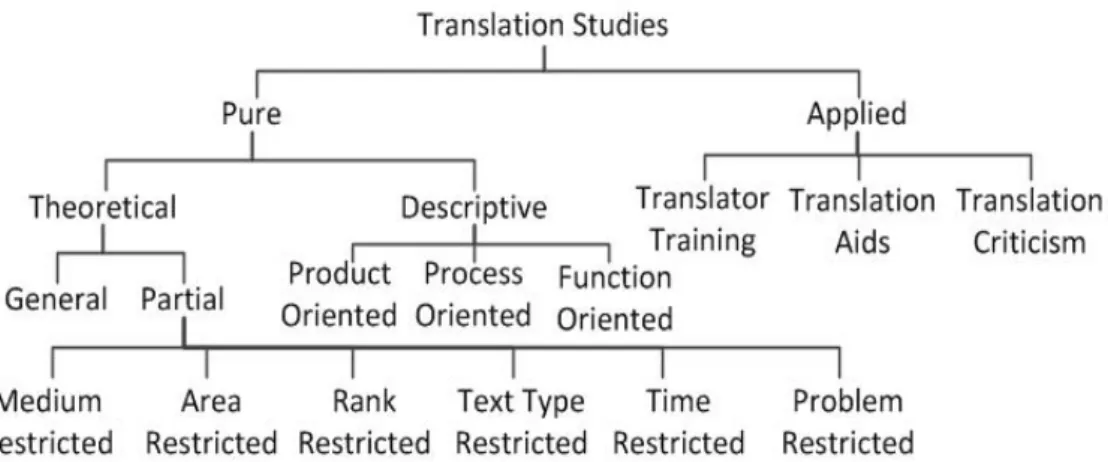
Methodology
Since cultures are not found in dictionaries, true cultural knowledge is found in the translator's head (Nida, 2001: 1). In order for the addressees of the Qur'an to clearly identify the concepts for which they stand, the translator must avoid foreignness and exoticism. Due to the large number of English translations of the Qur'an, more than fifty translations, it would be impossible and beyond the scope of this study to evaluate and analyze all existing versions.
Mohammad Al-Hilali and Mohammad Khan (1997) Translation of the Meanings of the Noble Qur'an into English. Since the objective of the study is to investigate the challenges encountered, review the strategies adopted, evaluate the shortcomings of the four translations of the Qur'an and measure. To ensure the validity (i.e. accuracy and consistency) and reliability (i.e. objectivity and relevance) of the questionnaire (the Sarantako copies were distributed directly to the respondents.
Therefore, this research design aimed to make it easy and clear for the respondents, to maximize the reliability of the findings and to establish accurate and consistent results. Qualitative data, obtained from in-depth cultural analysis of selected extracts (see Appendices 1-5), are reviewed briefly above and subjectively analyzed in Chapter 3. This research will adopt qualitative data collection through cultural analysis of any translation of the Qur'an.
Monolingual and bilingual dictionaries were consulted to verify losses in the translation of connotative meaning, i.e. the recommendations of the study will hopefully free future translations from the shortcomings observed in existing translations and help future translators to render the meaning of the Qur'an in English. as effectively as possible, in terms of readability, comprehensibility and appropriateness. After pilot testing and all necessary modifications, the questionnaires were administered directly to the sample selected for the purpose of the study.
After calculating the exact numbers and percentages of responses, the results of the study were presented statistically in four bar charts and interpreted textually according to the research questions (see Chapter 3 in Quantitative Data Analysis).
Discussion
- And put forward to them the example of
- Thou wouldst only, perchance,
- Perhaps, you, would kill yourself (O
- Then We roused them,
- Then We raised them up (from their
- We gave strength to
- And We made their hearts firm and strong
- So his fruits (and enjoyment) were
- So his fruits were encircled (with ruin)
- Praise be to Allah, Who
- All the praises and thanks be to Allah, Who
- Thus did We make their case
- And thus We made their case
- And the Book (of Deeds) will be
- Behold, Moses said to his
- And (remember) when Musa (Moses)
- For them will be Gardens of
- These! For them will be 'Adn (Eden)
- Each of those gardens brought
- Each of those two gardens brought forth
- And who doth more wrong than
- And who does more wrong than he
PRESENT to them the parable of the life of this world: it is like the water that We send down from the sky. And present to them the example of them, the example of the life of this world, it is like the water (rain) that We send down from heaven. The overall tafsir of this verse, in the second parable of the Sura, is that the rich man's fruits or crops (i.e. wealth, according to other interpreters) were surrounded and destroyed.
Therefore, the intended meaning of the hand gesture is not the superficial literal meaning, but rather the deep metonymic meaning, i.e. Through domestication, Ali's rendering comes closest to the intended image, though none of the above fully portrayed the TL reader. mental image similar to that evoked by the SL sentence. The designation of the word باتكلا is very clear in the Arabic text as the Arab Muslim reader knows very well that this term refers to the Holy Quran as this phrase appears in the Quran on several occasions.
What is striking is the translation of the Arabic ST word الله Allah, which is sometimes rendered as 'God' (as in Asad's and Abdel-Haleem's translations) and other times transliterated as 'Allah' (as in Ali's and Hilali-Khan's translations ). 34;I will not give up until I reach the crossroads of the two seas, even if I [have to]. According to tradition, it was Joshua who was to become the leader of the Israelites after the death of Moses.
However, TT3 slightly reduces the loss of the connotative meaning by designating the referent 'boy-servant'. Although the cultural flavor of the text is lost in all four translations, this translation loss is inevitable because of the cultural difference between SL and TL. 17 41 Like all other Qur'anic descriptions of events in the hereafter, the above refers to the believers' "adornment" with gold and jewels and silk and their.
Each of the two gardens yielded its produce and never failed in it, for We caused a stream to flow out in the midst of each of them. Semantic translation The context of the above verse is the second parable of the rich and poor man. Such SL terms and phrases of the particular Surah are: waseed (at the entrance), dakka' (flatten it), azka kos (purest), thamara (fruit), nutfah (offspring), husban (mighty rain), fisq (disobedience), `adudan (assistants), mawbiq (destruction), etc.
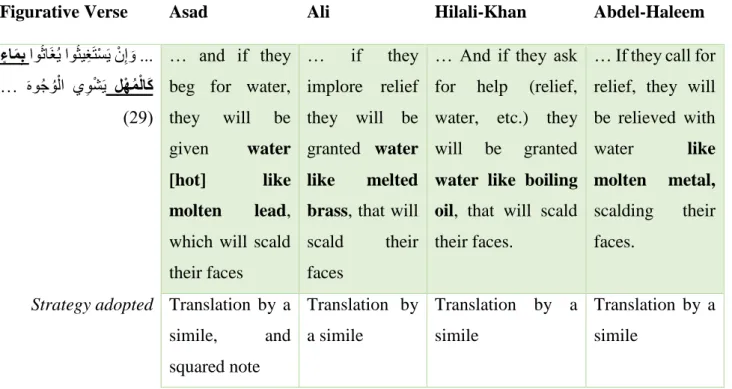
First Language
The above two graphs illustrate that the majority of the respondents are Arabic speakers and undergraduate students. Nevertheless, since all respondents are from Effat University, they usually have a good background knowledge of English in order to answer the questionnaire correctly. To achieve the goal of the study, the following four graphs statistically analyze the percentage of respondents' overall understanding, after which the study descriptively examines the results of the questionnaire, by comparing the four selected translations.
Level of Education
The graph above shows the most understood translation, according to the respondents of the questionnaire, the translations of Hilai-Khan at 40% (or 24 respondents). Consequently, a reader with little or no prior knowledge of the Qur'an or Islam is likely to misunderstand the translated verse. The graph above shows the most understood translations, according to the survey respondents, of Ali's followed by Hilali-Khan's translations (42% and 35% respectively).
In the preface to his book, he states that the purpose of his translation is to convey a picture of the rhetorical excellence and uniqueness of the Qur'an. This may stem from the fact that they have prior knowledge of the Qur'an and Arab culture having lived in the Arab world. This new translation of the Qur'an is written in contemporary language, suggesting that Abdel-Haleem's main focus is trying to make the Qur'an accessible to a contemporary reader, although he prioritizes readability over accuracy.
This new translation of the Qur'an is written in contemporary English that remains true to the meaning and spirit of the original. His introduction refers to the history of the Qur'an and examines its structure and stylistic features. One possible suggestion for future research would be the investigation of other problematic translation problems of the Noble Qur'an.
An application of this study to the rest of the Noble Qur'an can also be investigated in future research. Reasons for the possible unintelligibility of some verses of three translations of the meaning of the Holy Qur'an in English (Order No. U525146). Metaphors in Translation: An Examination of a Sample of Qur'anic Metaphors with Reference to Three English Versions of the Qur'an (Order No. 10048210).
I understand that the transcripts of the interview are securely stored in a locked filing cabinet in the Principal Investigator's office. Select the most comprehensive translation (a, b, c, d) of the underlined figures of speech that fully and understandably conveys the message. Select the least extensive translation (a, b, c, d) of the underlined figures of speech that does not adequately convey the message.
